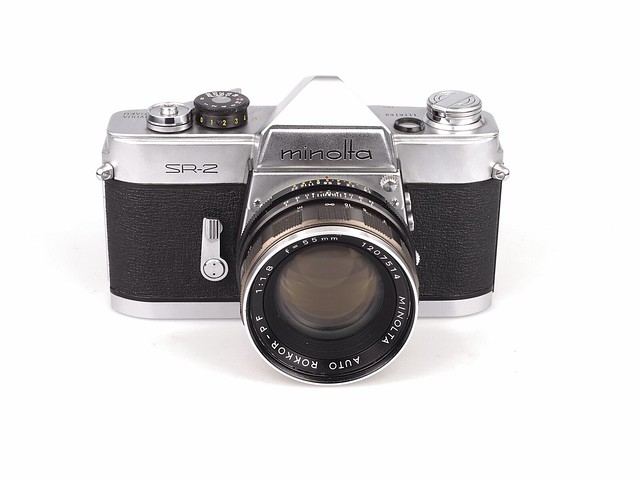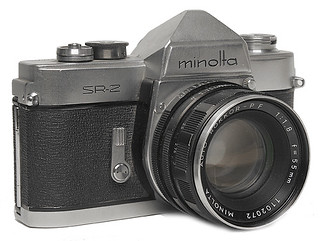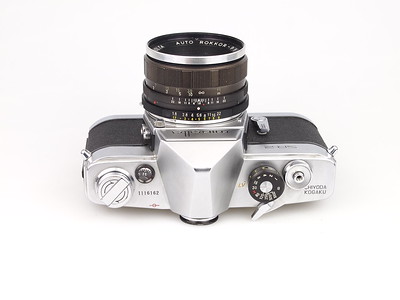Difference between revisions of "Minolta SR-2"
m (wiki-link to Minolta not disambig pg) |
|||
| (38 intermediate revisions by 14 users not shown) | |||
| Line 1: | Line 1: | ||
| − | |||
| − | The | + | {{Flickr image |
| + | | image_source=https://flic.kr/p/2kzbBra | ||
| + | | image=https://live.staticflickr.com/65535/50914985823_20a320d0d1_z.jpg | ||
| + | | image_align=right | ||
| + | | image_text=The first Minolta 35mm SLR | ||
| + | |image_by=Christoph Batz | ||
| + | |image_rights=cc | ||
| + | }} | ||
| + | The '''[[Minolta]] SR-2''' was introduced in 1958 as the first 35mm [[SLR]] camera from [[Minolta | Chiyoda Kōgaku Seikō]]. Having a remarkably advanced design, it paved the way for a whole series of successfull models for several decades to come, the same body being continuously refined right up to and including the [[Minolta XE-1]] of 1975 —which became the basis for the [[Leica R3]]. In this model, all the features to be included in any modern film based [[SLR]] camera came together for the first time: A bright [[Pentaprism|pentaprism]] finder with a rapid-return mirror, a wide bayonet lens mount for fast and convenient lens change with an internal automatic lens diaphragm mechanism, a single knob stationary shutter-speed dial, a fast thumb operated [[film advance]] lever with coaxial [[shutter release]], a combined rewind crank and back opening knob, a hinged door with an automatic frame-counter reset facility and a film-type reminder dial, FP and X PC sync terminals, and a convenient [[self timer]] sturdy enough to double as a finger grip. The SR-2 did not however reopen the lens aperture after exposure automatically, but by operating the film advance lever. So after that, no depth-of-field pre-view facility was present, although the more shrewd photographers found a way around this by turning the lens in its bayonet mount! The only important thing missing was the provision for an exposure meter. This was rectified in 1960 with the introduction of the model [[Minolta SR-3|SR-3]], having provision for a clip-on selenium meter being coupled to the shutter-speed-dial, and in 1962, came the first 35mm SLR camera with a built-in CdS meter with the introduction of the model [[Minolta SR-7|SR-7]]. | ||
| − | [[Category|Minolta | + | |
| + | * [[Pentaprism|Pentaprism]] | ||
| + | * Instant-return mirror | ||
| + | * Minolta SR bayonet lens mount with internal diaphragm operating lever | ||
| + | * Fast film advance / shutter tensioning lever with integrated shutter release knob | ||
| + | * Automatic preset lenses, closing aperture to preset value prior to exposure | ||
| + | * All shutter speeds set on a single stationary dial, 1 to 1/1000 sec. pluss B | ||
| + | * Combined rewind crank and back door release by pulling the knob up | ||
| + | * Internal frame counter with automatic reset when opening the back | ||
| + | |||
| + | |||
| + | However, just as important for the Chiyoda Kogaku success is the fact that they had to their disposal a brilliant team of lens designers and one of the most experienced and finest optical works making their own glass. The Rokkor lenses with the "Achromatic Coating" was produced taking advantage of their own advanced coating facilities. Shortly after the introduction of the SR-2, a large range of lenses and accessories was available. Several of the early lenses were superior, like the Rokkor PF 1:2 f=100mm and the remarkable Macro Rokkor QF 1:3.5 f=50mm. The latter has a Leica thread mount, but was supplied with a Minolta bayonet mount adapter, it focuses from infinity to 1:2 without the need for the included 1:1 intermediate ring. A remarkable curiosity is the fact that they subcontracted the manufacture of the macro bellows to Novoflex, the supplier of bellows to manufacturers like Hasselblad and Zeiss Ikon. | ||
| + | |||
| + | The introduction of the Minolta SR-2 marked the beginning of Chiyoda Kogaku's remarkable success subsequently placing the company among the few world-leading camera manufacturers for many decades to come. In July 1962, as the result of this international recognition, the company name was changed to Minolta Camera Company Ltd. | ||
| + | |||
| + | {|class=floatleft | ||
| + | | | ||
| + | {{Flickr image | ||
| + | | image_source=http://www.flickr.com/photos/ricksoloway/2206183509/in/pool-camerawiki | ||
| + | | image=http://farm3.static.flickr.com/2125/2206183509_ff2fc8ac17_n.jpg | ||
| + | | image_align=right | ||
| + | | image_text= | ||
| + | |image_by=Rick Soloway | ||
| + | |image_rights=wp | ||
| + | }} | ||
| + | | | ||
| + | {{Flickr_image | ||
| + | |image_source=https://flic.kr/p/2kzbBsn | ||
| + | |image= https://live.staticflickr.com/65535/50914985893_444859bcea_w.jpg | ||
| + | |image_align= left | ||
| + | |image_text= | ||
| + | |image_by=Christoph Batz | ||
| + | |image_rights=cc | ||
| + | }} | ||
| + | | | ||
| + | {{Flickr_image | ||
| + | |image_source= https://flic.kr/p/2kzfLZE | ||
| + | |image= https://live.staticflickr.com/65535/50915798432_427d6da5a8_w.jpg | ||
| + | |image_align= left | ||
| + | |image_text= | ||
| + | |image_by=Christoph Batz | ||
| + | |image_rights=cc | ||
| + | }} | ||
| + | |} | ||
| + | {{brl}} | ||
| + | ==Links== | ||
| + | *[https://www.butkus.org/chinon/minolta/minolta_sr-2/minolta_sr-2.htm Minolta SR-2 user manual] at [https://www.butkus.org/chinon/ Butkus.org] | ||
| + | * [http://www.subclub.org/minman/sr2.htm The SR-2 page] at the [http://www.subclub.org/minman/ MinMan website] | ||
| + | * [http://www.collection-appareils.fr/x/html/page_standard.php?id_appareil=11510 Minolta Sr-2] at [http://www.collection-appareils.fr Sylvain Halgand's collection d'appareils] (French) | ||
| + | * [http://progsch.net/mediawiki2/index.php?title=SR-2 SR-2] in[http://progsch.net/mediawiki2 Minowiki] (German) | ||
| + | |||
| + | [[Category:Minolta SR mount]] | ||
| + | [[Category:Minolta|SR-2]] | ||
| + | [[Category:M]] | ||
| + | [[Category:S|SR-2 Minolta]] | ||
| + | {{Minolta classic}} | ||
Latest revision as of 14:49, 22 November 2022

|
| The first Minolta 35mm SLR image by Christoph Batz (Image rights) |
The Minolta SR-2 was introduced in 1958 as the first 35mm SLR camera from Chiyoda Kōgaku Seikō. Having a remarkably advanced design, it paved the way for a whole series of successfull models for several decades to come, the same body being continuously refined right up to and including the Minolta XE-1 of 1975 —which became the basis for the Leica R3. In this model, all the features to be included in any modern film based SLR camera came together for the first time: A bright pentaprism finder with a rapid-return mirror, a wide bayonet lens mount for fast and convenient lens change with an internal automatic lens diaphragm mechanism, a single knob stationary shutter-speed dial, a fast thumb operated film advance lever with coaxial shutter release, a combined rewind crank and back opening knob, a hinged door with an automatic frame-counter reset facility and a film-type reminder dial, FP and X PC sync terminals, and a convenient self timer sturdy enough to double as a finger grip. The SR-2 did not however reopen the lens aperture after exposure automatically, but by operating the film advance lever. So after that, no depth-of-field pre-view facility was present, although the more shrewd photographers found a way around this by turning the lens in its bayonet mount! The only important thing missing was the provision for an exposure meter. This was rectified in 1960 with the introduction of the model SR-3, having provision for a clip-on selenium meter being coupled to the shutter-speed-dial, and in 1962, came the first 35mm SLR camera with a built-in CdS meter with the introduction of the model SR-7.
- Pentaprism
- Instant-return mirror
- Minolta SR bayonet lens mount with internal diaphragm operating lever
- Fast film advance / shutter tensioning lever with integrated shutter release knob
- Automatic preset lenses, closing aperture to preset value prior to exposure
- All shutter speeds set on a single stationary dial, 1 to 1/1000 sec. pluss B
- Combined rewind crank and back door release by pulling the knob up
- Internal frame counter with automatic reset when opening the back
However, just as important for the Chiyoda Kogaku success is the fact that they had to their disposal a brilliant team of lens designers and one of the most experienced and finest optical works making their own glass. The Rokkor lenses with the "Achromatic Coating" was produced taking advantage of their own advanced coating facilities. Shortly after the introduction of the SR-2, a large range of lenses and accessories was available. Several of the early lenses were superior, like the Rokkor PF 1:2 f=100mm and the remarkable Macro Rokkor QF 1:3.5 f=50mm. The latter has a Leica thread mount, but was supplied with a Minolta bayonet mount adapter, it focuses from infinity to 1:2 without the need for the included 1:1 intermediate ring. A remarkable curiosity is the fact that they subcontracted the manufacture of the macro bellows to Novoflex, the supplier of bellows to manufacturers like Hasselblad and Zeiss Ikon.
The introduction of the Minolta SR-2 marked the beginning of Chiyoda Kogaku's remarkable success subsequently placing the company among the few world-leading camera manufacturers for many decades to come. In July 1962, as the result of this international recognition, the company name was changed to Minolta Camera Company Ltd.
|
|
|
Links
- Minolta SR-2 user manual at Butkus.org
- The SR-2 page at the MinMan website
- Minolta Sr-2 at Sylvain Halgand's collection d'appareils (French)
- SR-2 inMinowiki (German)
| Minolta Classic Cameras |
|---|
| Vest (or Best) | V2 | SR-2 | SRT 101 | XE | XD | CLE | 7000 | 9000 | 800 si |


